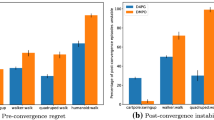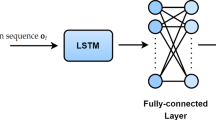Abstract
In this paper, we present a novel and domain-independent planner aimed at working in highly dynamic environments with time constraints. The planner follows the anytime principles: a first solution can be quickly computed and the quality of the final plan is improved as long as time is available. This way, the planner can provide either fast reactions or very good quality plans depending on the demands of the environment. As an on-line planner, it also offers important advantages: our planner allows the plan to start its execution before it is totally generated, unexpected events are efficiently tackled during execution, and sensing actions allow the acquisition of required information in partially observable domains. The planning algorithm is based on problem decomposition and relaxation techniques. The traditional relaxed planning graph has been adapted to this on-line framework by considering information about sensing actions and action costs. Results also show that our planner is competitive with other top-performing classical planners.
Similar content being viewed by others
References
Ambite JL, Knoblock CA (2001) Planning by rewriting. J Artif Intell Res 15:207–261
Benton J, Sanchez R, Do M, Kambhampati S (2005) Partial satisfaction planning. In: Workshop on decision making in adversarial domains, http://www.cs.umd.edu/~nau/adversarial/
Blum A, Furst M (1997) Fast planning through planning graph analysis. Artif Intell 90:281–300
Bonet B, Geffner H (2001) Planning as heuristic search. Artif Intell J 129:5–33
Briggs W, Cook DJ (1999) Anytime planning for optimal tradeoff between deliberative and reactive planning. In: Proceedings of the 1999 Florida AI research symposium (FLAIRS-99), pp 367–370
Castillo L, Fdez-Olivares J, Gonzalez A (2001) On the adequacy of hierarchical planning characteristics for real-world problem solving. In: European conference on planning (ECP-2001), pp 169–180
Chapman D (1987) Planning for conjunctive goals. Artif Intell 32:333–377
Chen Y, Hsu CW, Wah BW (2004) SGPlan: Subgoal partitioning and resolution in planning. In: IPC-4 booklet (ICAPS)
Chien S, Knight R, Stechert A, Sherwood R, Rabideau G (2000) Using iterative repair to improve the responsiveness of planning and scheduling. In: Proceedings of the 5th international conference on artificial intelligence planning and scheduling (AIPS)
Chun SB (1999) Wargaming. Air University Library, Maxwell AFB
Dean T, Kaelbling LP, Kirman J, Nicholson A (1995) Planning under time constraints in stochastic domains. Artif Intell 76:35–74
Dias MB, Lemai S, Muscettola N (2003) A real-time rover executive based on model-based reactive planning. In: 7th international symposium on artificial intelligence, robotics and automation in space
Do MB, Kambhampati S (2003) Sapa: A multi-objective metric temporal planner. J Artif Intell Res 20:155–194
Drummond M, Bresina J, Kedar S (1991) The entropy reduction engine: integrating planning, scheduling and control. SIGART Bull 2:61–65
Fikes RE, Nilsson NJ (1971) STRIPS: a new approach to the application of theorem proving to problem solving. Artif Intell 2:189–208
Fox M, Long D (2003) PDDL2.1: an extension to PDDL for expressing temporal planning domains. J Artif Intell Res 20:61–124
Gerevini A, Saetti A, Serina I (2003) Planning through stochastic local search and temporal action graphs in LPG. J Artif Intell Res 20:239–290
Gerevini A, Saetti A, Serina I, Toninelli P (2005) Fast planning in domains with derived predicates: an approach based on rule-action graphs and local search. In: Proceedings of the twentieth national conference on artificial intelligence (AAAI-05), pp 1157–1162
Gervasio M, Iba W, Langley P, Sage S (1998) Interactive adaptation for crisis response. In: AIPS-98 workshop on interactive and collaborative planning, pp 29–36
Ghallab M, Nau D, Traverso P (2004) Automated task planning. Theory and practice. Kaufmann, Los Altos
Gil Y, Deelman E, Blythe J, Kesselman C, Tangmunarunkit H (2004) Artificial intelligence and grids: workflow planning and beyond. IEEE Intell Syst, special issue on E-science, pp 26–33
Ginsberg ML (1989) Universal planning: an (almost) universally bad idea. AI Mag 10:40–44
Hawes N (2001) Anytime planning for agent behavior. In: Proceedings of the 12th workshop of PLANSIG, pp 157–166
Hoffman J, Nebel B (2001) The FF planning system: fast planning generation through heuristic search. J Artif Intell Res 14:253–302
Hoffman J (2003) The metric-FF planning system: translating ‘ignoring delete lists’ to numeric state variables. J Artif Intell Res 20:291–341
Knoblock CA (2003) Deploying information agents on the web. In: Proceedings of the 18th international joint conference on artificial intelligence (IJCAI), pp 1580–1586
Koehler J, Nebel B, Hoffmann J, Dimopoulos Y (1997) Extending planning graphs to an ADL subset. In: Proceedings of the fourth European conference in planning, pp 273–285
Koehler J, Hoffmann J (2000) On reasonable and forced goal orderings and their use in an agenda-driven planning algorithm. J Artif Intell Res 12:338–386
Koenig S (2001) Agent-centered search. Artif Intell Mag 22:109–131
Koenig S, Furcy D, Bauer C (2002) Heuristic search-based replanning. In: International conference on artificial intelligence planning and scheduling (AIPS), pp 310–317
Korf RE (1990) Real-time heuristic search. Artif Intell 42:189–211
Korf RE (1990) Depth-limited search for real-time problem solving. J Real-Time Syst 2:7–24
Lemai S, Ingrand F (2004) Interleaving temporal planning and execution in robotics domains. In: Proceedings of the national conference on artificial intelligence (AAAI)
Littman ML (1997) Probabilistic propositional planning: representations and complexity. In: Proceedings of the fourteenth national conference on artificial intelligence, pp 748–754
Matellan V, Borrajo D (1998) Combining classical and reactive planning: the ABC2 model. In: AIPS’98 workshop on integrating planning, scheduling and execution in dynamic and uncertain environments, pp 121–126
Nareyek A (2004) Artificial intelligence in computer games—state of the art and future directions. ACM Queue 1:58–65
Nebel B, Koehler J (1995) Plan reuse versus plan generation: a theoretical and empirical analysis. Artif Intell 76:427–454
Pryor L, Collins G (1996) Planning for contingencies: a decision-based approach. J Artif Intell Res 4:287–339
Refanidis I, Vlahavas I (2001) The GRT planning system: backward heuristic construction in forward state-space planning. J Artif Intell Res 15:115–161
Sanchez J, Mali AD (2003) S-MEP: a planner for numeric goals. In: Proceedings of IEEE ICTAI, pp 274–283
Sapena O, Onainda E, Mellado M, Correcher C, Vendrell E (2004) Reactive planning simulation in dynamic environments with VirtualRobot. In: Proceedings of IEA-AIE. Lecture notes in computer science, vol 3029, pp 699–707
Schoppers MJ (1987) Universal plans for reactive robots in unpredictable domains. In: Proceedings of the 10th international joint conference on artificial intelligence (IJCAI), pp 1039–1046
Sebastia L, Onaindia E, Marzal E (2001) STeLLa: an optimal sequential and parallel planner. In: Proceedings of EPIA. Lecture notes in artificial intelligence. Springer, Berlin, pp 409–416
Simmons R et al. (2003) GRACE: an autonomous robot for the AAAI robot challenge. AAAI Mag 24:51–72
Smith DE, Weld DS (1998) Conformant graphplan. In: Proceedings of the national conference on artificial intelligence, pp 889–896
Thiebaux S, Hertzberg J, Shoaff W, Schneider M (1995) A stochastic model of actions and plans for anytime planning under uncertainty. Int J Intell Syst 10:155–183
Washington R (1995) Incremental planning for truly integrated planning and reaction. Proc SCAI 28:305–316
Weld DS (1994) An introduction to least commitment planning. AI Mag 15
Wilkins DE (1988) Practical planning: extending the classical AI planning paradigm. Kaufmann, Los Altos
Yang Q (1997) Intelligent planning. A decomposition and abstraction based approach. Springer, Berlin
Zilberstein S (1996) Using anytime algorithms in intelligent systems. AI Mag 17:73–83
Author information
Authors and Affiliations
Corresponding author
Rights and permissions
About this article
Cite this article
Sapena, O., Onaindía, E. Planning in highly dynamic environments: an anytime approach for planning under time constraints. Appl Intell 29, 90–109 (2008). https://doi.org/10.1007/s10489-007-0083-x
Received:
Accepted:
Published:
Issue Date:
DOI: https://doi.org/10.1007/s10489-007-0083-x




